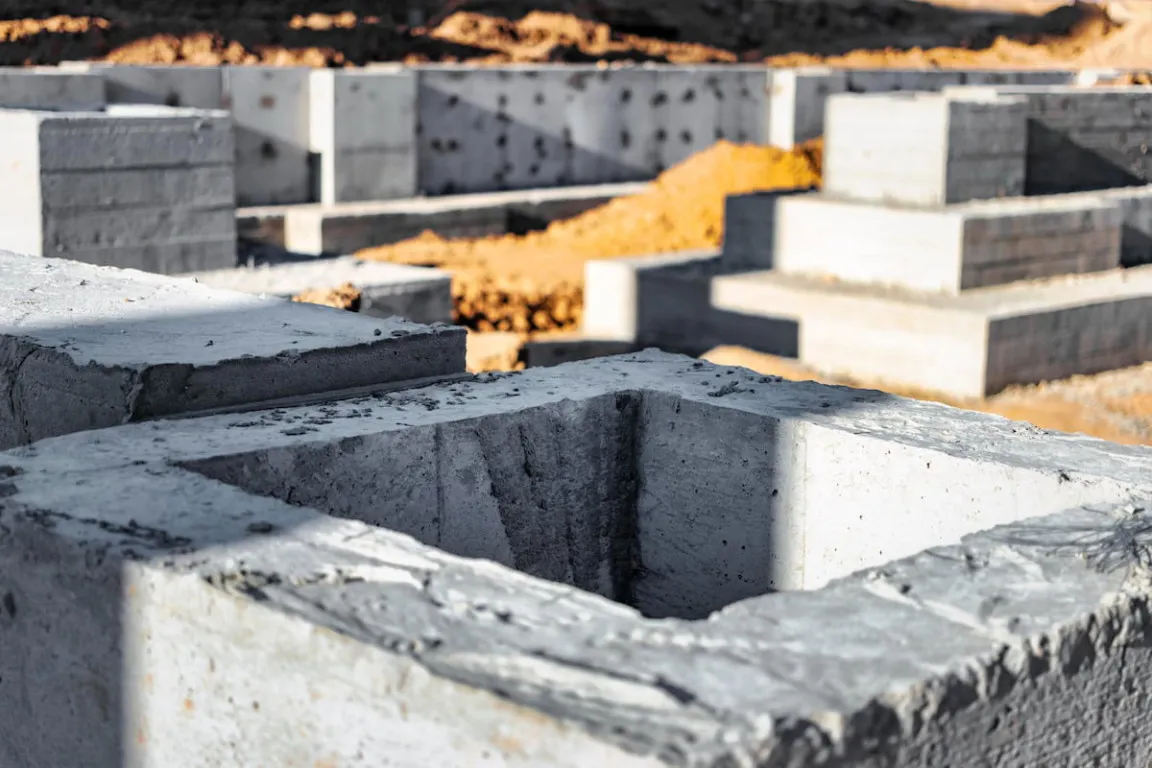In constructing concrete building structures, the factors of strength and durability must be the top priority, as they are directly related to the safety of users. One of the components that supports the strength and durability of concrete structures is the concrete cover.
Yes, the concrete cover is a mandatory element in all building structures that use reinforced concrete, whether in the form of residential houses, multi-storey buildings, bridges, or underground structures.
To understand the various uses of concrete cover, the best way to create it, and the proper steps for its maintenance, see the explanation below.
What Is Concrete Cover?
Concrete cover is the outer protective layer that protects the rebar in a building. This layer is located between the concrete surface and the reinforcing steel within it.
Concrete cover is made from a mixture of concrete that is applied to the structural elements of a building, such as slabs and columns. This mixture varies depending on the needs of the construction project.
Functions and Uses of Concrete Cover
Below are several functions of concrete cover that you need to know:
1. Protection from Corrosion
Corrosion is the damage or degradation of an object, particularly metals, due to direct contact with the surrounding environment. This condition can worsen the appearance and quality of metal materials.
If the steel reinforcement in a building is exposed to external factors, such as humid air, water, and aggressive substances continuously, the risk of corrosion can increase. Consequently, this can potentially reduce the durability of the concrete structure.
This is where concrete cover plays a role in protecting the steel reinforcement from exposure to external factors. This protection helps slow the rate of corrosion so that the strength of the building's structural elements is maintained.
2. Protection from Extreme Temperatures
Extreme temperature changes, whether in winter or summer, will affect the condition of concrete structures. As a protective layer, concrete cover helps prevent cracking on the concrete surface caused by thermal contraction (shrinkage) and expansion (dilation).
3. Fire Protection
During a fire, the internal layers of a building, such as plaster, are exposed to heat first. The function of a thick concrete cover is to slow down the heat transfer to the steel reinforcement, thereby protecting it from extreme fire temperatures, which can reach 300–1000 °C.
Thus, concrete structures can remain strong even when faced with such emergency conditions.
4. Supporting the Stability of Concrete Structures
With its ability to protect reinforcement from corrosion and extreme temperatures, concrete cover indirectly helps maintain the stability and integrity of the structure.
In addition, the function of concrete cover is also to ensure that the position of the reinforcement remains according to the original design, so that the load distribution is even and the structure can function optimally for a long time.
Read also: How to Build a Concrete Wall for Optimal Durability, Take Notes!
Thickness of Concrete Cover in Building Structures
According to Indonesian National Standards (SNI) 2847:2019 Article 20.7.5, the thickness of concrete cover is indeed regulated, and for certain specific conditions, the minimum thickness of concrete cover is 20 mm, especially for reinforcement with a specific diameter and in structural parts that are not directly exposed to weather or ground, such as main reinforcement, ties, stirrups, and spiral ties in beams and columns.
The thickness of concrete cover can be calculated from:
- The outermost side of stirrups, ties, and spirals, if applied on the transverse reinforcement that covers the main reinforcement.
- The outermost layer of reinforcement, if there is more than one layer of reinforcement used without stirrups or ties.
- The end-binding metal or sleeve of post-tension tendons, or from the outermost part of heads, if applied on headed reinforcing bars.
SNI also establishes the standard thickness of concrete cover differentiated by exposure type, structural components, and rebar size. The requirements for concrete cover according to SNI can be seen in the table below:
1. Non-Prestressed Thickness
|
Exposure |
Structural Components |
Reinforcement |
Cover Thickness (mm) |
|
Not exposed to weather or contact with the soil |
Plates, ribbed plates, and walls |
Bars D43 and D57 |
40 |
|
Bars D36 and smaller |
20 |
||
|
Beams, columns, pedestals, and tension bars |
Main reinforcement, stirrups, tie stirrups, spirals, and restraint stirrups |
40 |
|
|
Exposed to weather or contact with the soil |
All |
Stems D19 to D57 |
40 |
|
Stems D16, wire ∅13 or D13 and smaller |
40 |
||
|
Coated and permanently in contact with the ground |
All |
All |
75 |
2. Prestressed Thickness
|
Exposure |
Structural Components |
Reinforcement Type |
Cover Thickness (mm) |
|
Not exposed to weather or soil |
Plates, ribbed plates, and walls |
Steel bar diameter D43–D57, tendon > 40 mm |
30 |
|
Tendon/strand diameter ≤ 40mm |
20 |
||
|
Steel bar diameter D36 or smaller |
16 |
||
|
Beams, columns, and tension bars |
Main reinforcement |
>16, maximum 40 |
|
|
Stirrups, spirals, etc |
10 |
||
|
Exposed to weather or contact with the soil |
Wall |
Steel bar D43–D57, tendon > 40 mm |
40 |
|
Steel bar diameter D36 or smaller, wire ∅13, tendon diameter ≤ 40mm |
20 |
||
|
Non-wall |
Steel bar D43–D57, tendon > 40 mm |
50 |
|
|
Steel bar diameter D19–D36, tendon diameter > 16–40 mm |
40 |
||
|
Steel bar diameter D16, wire ∅13, tendon diameter ≤ 16 mm |
30 |
Factors Affecting the Thickness of Concrete Cover
It has been previously mentioned that the thickness of concrete cover can vary. Several factors that affect the differences in concrete cover thickness include:
1. Location and Function of the Structure
Concrete cover in underground structures is generally thicker than that in above-ground structures.
Moreover, structures that bear higher loads and stresses also require thicker concrete cover, as it is used to prevent structural damage.
2. Type of Structure
The type of structure, such as beams, slabs, and columns, determines the thickness of the concrete cover. For example, the concrete cover for columns generally has a thickness of 40 mm, while the concrete cover for beams typically ranges from 25–30 mm.
3. Environmental Conditions
Environmental conditions are external factors that also determine the size of the concrete cover. Some of these external factors include humidity, temperature, corrosion potential, and exposure to chemicals.
4. Types of Additives
Furthermore, the thickness of the concrete cover is also influenced by the additives involved. If the concrete mix receives additional substances or fibers that have reinforcing properties, you can reduce the thickness of the concrete cover.
5. Size of Reinforcement
The last factor that affects the thickness of the concrete cover is the diameter of the reinforcement and the spacing between the reinforcements. Note that the larger the diameter of the reinforcement, the larger the concrete cover required.
Read also: Get to Know Manual Concrete Casting Measurements Based on SNI
Concrete Cover Maintenance Tips
Even though the construction of the concrete structure is complete, it does not mean you can neglect its condition afterward. Remember, significant damage can pose greater risks. Therefore, follow these concrete cover maintenance tips:
1. Regular Monitoring and Cleaning
Periodic monitoring or inspection needs to be conducted to identify signs of corrosion and damage to the reinforcement.
In addition to monitoring, it is also necessary to clean it with clean water and a soft-bristled brush to remove stains and chemicals.
2. Prompt Repairs
To prevent more severe damage, immediately repair any structures that are experiencing corrosion or damage. You can use appropriate materials that match the type of concrete cover.
3. Providing Additional Protection
If the concrete structure is in an aggressive environment, you may need to provide additional protection, such as coating it with anti-corrosion or using a cathodic protection system.
That is a complete explanation regarding concrete cover, as a crucial element that must receive attention from the manufacturing process to post-construction maintenance.
To enhance the strength of the concrete structure, what needs to be considered is not only the accuracy of the size and the application technique of the mixture, but also the selection of quality materials.
If you are looking for high-quality premium material products that also facilitate the construction process, trust Semen Merah Putih.
Through one of its subsidiaries, Beton Merah Putih, Semen Merah Putih supplies innovative ready-mix concrete products designed for various unique and strong applications, including its flagship products, Ready Mix Concrete and Precast Concrete.
The ready-to-use concrete products from Beton Merah Putih are designed for a variety of applications tailored to consumer demands. Available in various quality options for the construction of different structures, such as industrial, commercial, and infrastructure projects, including high-rise buildings, housing, highways, and other construction activities.
Contact us now for more information about other Semen Merah Putih products and find the best construction solutions for your project!
Read also: 3 Ideas to Enhance the Look of Concrete Construction



